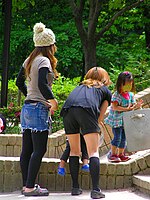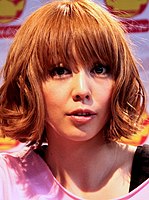Chapatsu

Chapatsu (茶髪/ちゃぱつ), literally "
Etymology
The word chapatsu is formed from two
Style
While the style itself began to show up in Tokyo streets during the early to mid-1990s, chapatsu was first described in Imidas, an annual publication of new words and concepts in the Japanese language, in 1997. Chapatsu did not appear in Kōjien, an authoritative dictionary of the Japanese language, until 1998. The style first gained popularity among adolescent girls, seeking to accentuate their tanned skin (rebelling against more traditional definitions of beauty), but quickly became mainstream.[2] By the mid-2000s, however, trends seemed to indicate that the "chapatsu" as a mainstream style was on its way out.[5] Although chapatsu died out as youth-centered fashion trend of rebellion, it came to be accepted not only on young people but also in certain business settings, and it was established before long as a Japanese fashion.[citation needed]
-
The brown hair also became popular with Yanmama (young mothers).
-
Japanese singer Yumi Yoshimura with a chapatsu.
See also
References
- ^ OCLC 56431036. Archived from the originalon 2007-08-25. Retrieved 2012-07-26.
- ^ OCLC 506996961. Archived from the originalon 2007-08-25. Retrieved 2012-07-26.
- ^ "Brown But Not Brazen". Trends in Japan. 3 February 1999. Retrieved 6 October 2012.
- OCLC 56431036. Archived from the originalon 2007-08-25. Retrieved 2012-07-26.
- ^ Dyejobs make for the nearest stylist as hair experts proclaim black is back Archived March 9, 2008, at the Wayback Machine
External links


